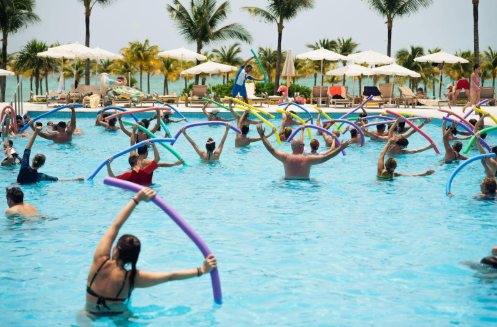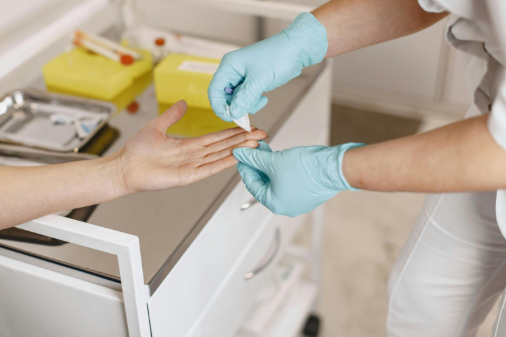May 1, 2025
Water Therapy for Joint Pain: The Benefits of Swimming and Aquatic Exercise
Water Therapy for Joint Pain: The Benefits of Swimming and Aquatic Exercise

Joint pain can make everyday activities feel like a challenge. Whether it's due to arthritis, an injury, or general wear and tear, finding relief is a priority for many people.
While traditional exercises like running or weightlifting might put too much strain on aching joints, water therapy offers a gentler alternative. Swimming and aquatic exercises provide a low-impact way to stay active while easing discomfort.
How Water Therapy Helps Reduce Joint Pain
Water has unique properties that make it an excellent medium for exercise, especially for those struggling with joint pain. The natural buoyancy of water supports your body weight, which reduces the impact on your joints. This means movements that might be painful on land—like walking or bending—become easier and more comfortable in water.
In addition to buoyancy, water also provides gentle resistance. Unlike gym machines or free weights, which can sometimes cause strain, water’s resistance is smooth and even. This allows for muscle strengthening without the risk of sudden, jerky movements that could worsen joint pain. The warmth of heated pools can also soothe stiff joints and improve circulation, further reducing discomfort.
Swimming: A Full-Body Workout with Low Impact
Swimming is one of the best exercises for people with joint pain because it engages the entire body without putting stress on the joints. When you swim, your muscles work against the natural resistance of the water, which helps build strength and flexibility. At the same time, the rhythmic motion of swimming improves cardiovascular health, promoting better circulation and reducing inflammation.
Different strokes offer varying benefits. Freestyle and backstroke provide gentle, flowing movements that keep the body aligned and supported. The breaststroke, while slightly more challenging, encourages mobility in the knees and hips. For those with more severe joint pain, the backstroke is often the easiest, as it allows for movement without requiring weight-bearing motions.
Even if traditional swimming strokes are too intense, simply moving through the water can still provide significant benefits. Walking, stretching, or floating in a pool can help loosen tight muscles and encourage better mobility.
Aquatic Exercise: Strengthening Without Strain
For those who prefer structured workouts, aquatic exercise classes can be a great option. These classes often include water aerobics, resistance exercises, and flexibility training, all of which help improve joint health without causing additional pain.
Water aerobics involves performing movements like leg lifts, arm circles, and gentle jumping in waist- to chest-deep water. Since water reduces the effects of gravity, these exercises are easier on the body than land-based versions. Many classes incorporate equipment like foam dumbbells or resistance bands designed for underwater use, helping participants build muscle strength safely.
Hydrotherapy, a more specialized form of aquatic exercise, often takes place in heated pools and focuses on targeted movements to relieve pain.
Physical therapists frequently recommend hydrotherapy for individuals recovering from surgery or dealing with chronic conditions like osteoarthritis.
Why Water Therapy Works for Arthritis and Other Joint Conditions
Many people with arthritis find it difficult to engage in land-based exercise because of pain and stiffness; however, movement is good for maintaining joint health, as inactivity can lead to further stiffness and muscle loss. Water therapy offers a way to stay active without aggravating symptoms.
For those with osteoarthritis, water exercise can help lubricate the joints by increasing blood flow. The warmth of the water also relaxes tense muscles, making movement easier. Rheumatoid arthritis sufferers may benefit from the anti-inflammatory effects of swimming, as regular exercise can help regulate the immune system’s response.
Beyond arthritis, water therapy is beneficial for individuals recovering from joint surgery, such as knee or hip replacements. Since the water supports body weight, patients can begin moving earlier in their recovery without placing undue stress on healing joints.
Improving Balance and Mobility with Water Workouts
One of the lesser-known benefits of aquatic exercise is its ability to improve balance and coordination. Many joint issues, especially those affecting the knees and hips, can lead to instability and an increased risk of falls. Water workouts provide a safe environment to practice balance-enhancing exercises without the fear of falling.
By engaging core muscles and encouraging controlled movements, water therapy helps individuals regain confidence in their mobility. Over time, these improvements can translate to better stability on land, reducing the likelihood of injury.
The Mental Health Benefits of Water Therapy
Joint pain doesn’t just affect the body—it can take a toll on mental health as well. Constant discomfort can easily lead to stress, anxiety, and even depression. Exercise, in general, is known to boost mood, but aquatic exercise provides additional mental health benefits.
The calming sensation of being in water can help lower stress levels, promoting relaxation and overall well-being. The rhythmic movements involved in swimming or gentle water exercises can have a meditative effect, allowing participants to focus on their breath and movements rather than their pain. Many people find that simply being in water provides a sense of freedom they don’t experience on land, which can be incredibly uplifting.
Getting Started with Water Therapy
If you’re interested in trying water therapy for joint pain, it’s important to start slow and listen to your body. Heated pools are ideal for reducing stiffness, so look for aquatic exercise programs held in warm water. Community pools, fitness centers, and physical therapy clinics often offer classes designed for people with joint pain.
For beginners, gentle movements like walking in the shallow end, side leg lifts, and arm circles can help ease stiffness. Gradually incorporating more challenging exercises, like swimming laps or using water resistance equipment, can further enhance joint mobility and strength.
If you have a specific medical condition, consulting with a
doctor or physical therapist before starting an aquatic exercise routine is a good idea. They can help tailor a program that suits your needs and ensures you’re engaging in movements that support, rather than strain, your joints.
Making Water Therapy a Long-Term Habit
One of the best aspects of water therapy is that it’s enjoyable. Unlike some forms of exercise that can feel like a chore, swimming and aquatic workouts are often fun and refreshing. Many people find that once they start, they look forward to their time in the water.
To make water therapy a consistent part of your routine, consider scheduling regular pool sessions and trying different activities to keep things interesting. Swimming laps one day, joining a water aerobics class another, and simply floating or stretching on another can keep your workouts varied and engaging.
The Social Benefits of Water Therapy
One of the often-overlooked advantages of water therapy is the social connection it can foster. Many aquatic exercise programs are held in group settings, whether it's a water aerobics class, a rehabilitation program, or a community swim group. Participating in these activities provides an opportunity to connect with others who may be experiencing similar joint pain challenges.
Exercising in a supportive and encouraging environment can be incredibly motivating. Having workout partners can make staying active feel more enjoyable and less like a chore. For many people, the friendships built in water therapy classes become an important part of their wellness journey. The social aspect also helps reduce feelings of isolation, which can sometimes accompany chronic pain conditions.
To learn more about the
Bayou Bend Fitness Center, including the indoor lap and therapy pools, call
(337) 413-5106 or visit
1029 Northwest Boulevard in Franklin, LA.
At
Bayou Bend Health System, we put our patients—and their health—first. If you want more information on how we can help make your joint pain go away,
contact us today!



